Hertfordshire Fire and Rescue Service
 | |
| Operational area | |
|---|---|
| Country | England |
| Address | Hertford, Hertfordshire, SG13 7LD |
| Agency overview | |
| Established | 1925 |
| Employees | 1,000 |
| Chief Fire Officer | Darryl Keen |
| Facilities and equipment | |
| Stations | 29 |
| Website | |
| www | |
Hertfordshire Fire and Rescue Service (HFRS) is the statutory fire and rescue service for the county of Hertfordshire, England. HFRS covers an area of 1,514 square miles (3,920 km2) and a population of 1.19 million.[1]
The Service Headquarters is located in Hertford whilst the Training and Development Centre (JESA (Joint Emergency Services Academy)) and Fire Control Centre are located in Stevenage. It is administered by a Fire Authority which is an internal part of Hertfordshire County Council. The Chief Fire Officer is Darryl Keen, assisted by Deputy Chief Fire Officer Chris Bigland.
In December 2005, the service dealt with what is thought to be the largest fire since World War II following an explosion at the Buncefield oil depot near Hemel Hempstead. The incident saw a large scale national response involving many UK fire services.
Organisation[]
HFRS has 29 fire stations and 40 fire appliances.[1] The stations use a number of crewing models:[2]
- Wholetime fire station. 24/7 crewed.4 watches working 2 days, 2 nights, 4 rest days
- Wholetime + On-call fire station As wholetime station but with a second on call fire engine, where firefighters have another primary job and respond via pager from home or work when available
- Day-crewed fire station. Daytime cover on station, night time via pager from home
- Day-crewed PLUS fire station Daytime cover on station, night time via pager from adjacent accommodation block
- On Call Fire Station. Firefighters have another primary job and respond via pager from home or work when available
The protection area includes four large settlements with a population between 50,000 and 100,000: Hemel Hempstead, Stevenage Watford, and the city of St Albans.[1] Almost 89% of residents live in urban areas, comprising 32% of the county; while the remaining population live in the 67% of the county that is rural.[2]
Gallery[]

A Typical Hertfordshire Fire Engine

One of Hertfordshire's Aerial Ladder Platforms. Based at Stevenage & Watford
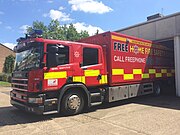
Hertfordshire Fire & Rescue's DEPU. Based at Hemel Hempstead
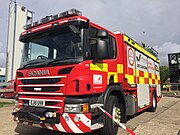
Hertfordshire's Rescue Support Unit. Based at St Albans
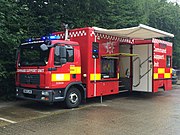
Hertfordshire Fire & Rescue's Command Support Unit. Based at Hertford

Hertfordshire's Water Rescue Unit. Based at Hatfield
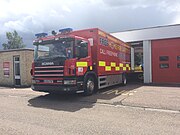
One of Hertfordshire's Incident Support Units. Based at Rickmansworth & Hitchin

Two Hertfordshire Fire Engines responding from Hemel Hempstead

Several Hertfordshire Appliances Lined Up
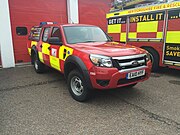
One of Hertfordshire's 4x4 Tenders
See also[]
References[]
- ^ Jump up to: a b c "Hertfordshire Fire and Rescue Service". HMICFRS. Retrieved 14 June 2021.
- ^ Jump up to: a b "Integrated Risk Management Plan 2019-2023" (PDF). Hertfordshire Fire and Rescue Service. Retrieved 14 June 2021.
External links[]
| Wikimedia Commons has media related to Hertfordshire Fire and Rescue. |
- Fire and rescue services of England
- Learning and Skills Beacons









